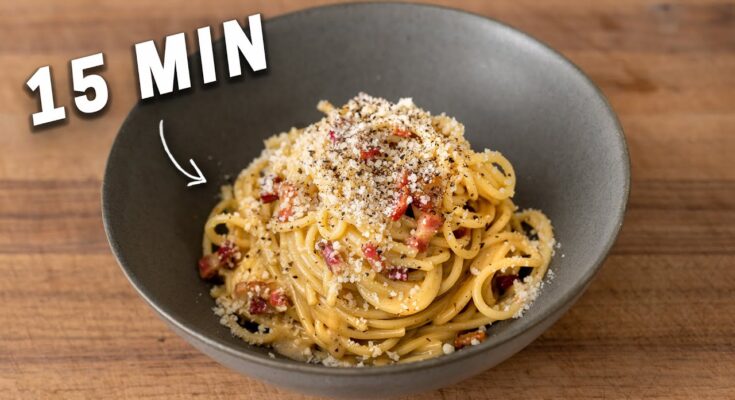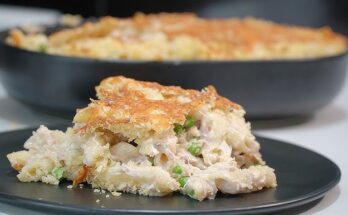Spaghetti Carbonara Recipe: Spaghetti Carbonara is one of those comforting Italian dishes that never goes out of style. It’s creamy, savory, and has just the right amount of richness to satisfy any pasta craving. But here’s the twist – there’s no cream involved! Traditional Carbonara is made using eggs, cheese, pancetta, and pepper. That’s it. It’s simple, yet it packs a punch in terms of flavor. The sauce forms as the eggs and cheese emulsify with the hot pasta, creating that luscious, silky coating we all crave.
Carbonara isn’t just about cooking—it’s about timing, precision, and a little bit of love. It’s one of those recipes that’s more than the sum of its parts, and once you’ve mastered it, you’ll never want to go back to the jarred Alfredo sauces again.
A Brief History of Carbonara
The roots of Carbonara are actually not as ancient as other Italian recipes. Many believe it originated in Rome around the mid-20th century. Some say it was born out of necessity when American soldiers in Italy during World War II brought bacon and eggs, and the Italians took those ingredients and made magic happen with their local pasta.
There are also theories tying it back to coal miners (the word “carbonaro” means “charcoal burner” in Italian), suggesting that this hearty, quick-to-prepare meal was ideal for workers. Regardless of its origin, what we do know is that it quickly became an iconic part of Italian cuisine.
Ingredients You’ll Need
Classic Ingredients List
To make an authentic Spaghetti Carbonara, you don’t need a long list of fancy items. Here’s what you’ll need for 2 servings:
- 200g (7 oz) of spaghetti
- 100g (3.5 oz) of pancetta or guanciale (Italian cured pork cheek)
- 2 large eggs
- ½ cup freshly grated Pecorino Romano cheese
- Freshly ground black pepper (to taste)
- Salt (for pasta water)
These ingredients may seem minimal, but the combination is a perfect example of Italian cooking philosophy: fewer ingredients, better quality, more flavor.
Tips on Choosing the Best Ingredients
Let’s break it down:
- Pasta: Traditional Carbonara uses spaghetti, but feel free to experiment with other pasta types like fettuccine or bucatini.
- Pancetta or Guanciale: If you can get guanciale, go for it. It has a deeper flavor and richer fat content than pancetta. Bacon can be a backup, but it will give the dish a smoky taste.
- Cheese: Pecorino Romano is the gold standard. Parmesan is acceptable in a pinch but will change the flavor profile slightly.
- Eggs: Use fresh, large eggs. The yolks are where the magic happens.
- Pepper: Freshly cracked black pepper gives Carbonara that spicy kick it needs.
Your ingredient quality will determine the end result, so don’t skimp on this part. Buy the best you can afford, and you’ll taste the difference.
How to Make Spaghetti Carbonara – Step by Step Guide
Step 1: Boil the Pasta
Start with boiling a large pot of salted water. Think of the water as your first seasoning opportunity. It should taste like the sea—salty but not overwhelming. Add your spaghetti and cook it al dente according to the package directions. Usually, this takes around 8-10 minutes.
Why al dente? Because pasta continues to cook a little even after you drain it, and you want it to maintain that firm bite. Don’t toss the pasta water—you’ll need it later to loosen up the sauce and help it stick.
Step 2: Prepare the Sauce Base
While your pasta’s cooking, dice your pancetta or guanciale and cook it in a pan over medium heat until it turns crispy and golden. You want that fat to render out beautifully—it’s liquid gold for your Carbonara sauce.
In a separate bowl, whisk together the eggs, grated Pecorino Romano, and a generous amount of cracked black pepper. This is your creamy, cheesy sauce base. Notice, still no cream involved. The heat of the pasta will cook the eggs and melt the cheese—no stovetop sauce required.
Step 3: Combine Pasta with Sauce
Once your pasta is cooked and drained (remember to keep about 1 cup of that pasta water), toss it right into the pan with the crispy pancetta. Turn off the heat and quickly pour in the egg and cheese mixture, stirring vigorously.
This part is all about timing. The residual heat from the pasta cooks the eggs gently—too much heat, and you’ll end up with scrambled eggs. Stir and add reserved pasta water a little at a time until the sauce is smooth and glossy, coating every strand of spaghetti.
Now, give it a taste. Want more pepper? Go for it. More cheese? Why not. This is your Carbonara—make it perfect for your palate.
Cooking Tips for Perfect Carbonara
Temperature Control is Key
Here’s the deal: high heat is your enemy when mixing the sauce. You don’t want to throw your egg mixture into a sizzling hot pan, or you’ll end up with a pasta-omelet. Once your pancetta is done and pasta is mixed in, kill the heat before adding the eggs.
The goal is a creamy, glossy sauce—not scrambled eggs. The trick is letting the eggs set from the residual heat of the pasta and the pan.
Avoiding Scrambled Eggs in Your Sauce
To avoid any breakfast mishaps in your dinner bowl, make sure to:
- Let the pan cool slightly before mixing
- Stir vigorously while pouring in the egg mixture
- Add pasta water gradually to loosen and smooth out the sauce
This will give you that signature creamy texture that makes Carbonara shine.
Serving and Enjoying Your Carbonara
Perfect Garnishes and Pairings
When your Carbonara is ready, it’s time to dress it up just a little. While the dish is rich and flavorful on its own, the right garnishes and pairings can elevate the experience.
Garnish Suggestions:
- Extra Pecorino Romano: Sprinkle a bit more cheese over the top before serving.
- Cracked Black Pepper: A fresh twist of pepper adds a nice visual touch and an extra kick.
- Fresh Parsley (optional): Not traditional, but it can add a touch of color and freshness.
Pairing Ideas:
- Wine: A crisp white wine like Pinot Grigio or a light red like Chianti complements the richness.
- Salad: A simple arugula salad with lemon vinaigrette adds brightness to the meal.
- Bread: A slice of crusty Italian bread is perfect for mopping up any leftover sauce.
Serve immediately. Carbonara doesn’t sit well for too long. The sauce can thicken and lose its silky texture, so make sure everything is timed right and eaten while it’s still warm.
Common Mistakes to Avoid
Even though Carbonara is simple in theory, a few common pitfalls can lead you astray:
- Using Cream: Traditional Carbonara does not include cream. The sauce should be made solely from eggs and cheese. Adding cream may make it richer but sacrifices authenticity.
- Overheating the Eggs: Scrambled egg pasta is not the goal. Always take the pan off the heat before adding the egg mixture.
- Not Using Pasta Water: This starchy liquid is crucial for loosening the sauce and making it glossy.
- Using Pre-Grated Cheese: It might seem convenient, but pre-grated cheese often contains anti-caking agents that can affect the sauce’s texture. Always grate fresh cheese.
- Underseasoning: Salt your pasta water generously and taste the final dish. The cheese and pancetta add saltiness, but black pepper is your main seasoning here.
Avoiding these mistakes will help you craft a more authentic, delicious Carbonara every single time.
FAQs about Spaghetti Carbonara Recipe
1. What are the traditional ingredients for Spaghetti Carbonara?
The classic Spaghetti Carbonara is made with just a few key ingredients: spaghetti, cured pork (typically guanciale, but pancetta can be used as a substitute), eggs, Pecorino Romano cheese, and freshly ground black pepper. The simplicity of the ingredients highlights the dish’s rich flavors and creamy texture.
2. Can I use bacon instead of guanciale or pancetta in Carbonara?
Yes, you can use bacon as an alternative if guanciale or pancetta are not available. Keep in mind that bacon will add a smokier flavor compared to the more traditional ingredients.
3. Is cream used in authentic Spaghetti Carbonara?
No, cream is not used in traditional Spaghetti Carbonara. The creamy consistency is achieved by combining the eggs and cheese properly with the hot pasta, which cooks the eggs gently and creates a rich, silky sauce.
4. How do I prevent the eggs from scrambling in the sauce?
To avoid scrambling the eggs, make sure to mix the egg and cheese mixture into the pasta off the heat. The residual heat from the pasta will cook the eggs sufficiently without turning them into scrambled eggs. Stir vigorously to create a smooth, even sauce.
5. What type of pasta is best for Carbonara?
Spaghetti is the traditional choice for Carbonara, but other long, thin pasta like linguine or fettuccine can also work well. The key is to use pasta that will hold onto the creamy sauce effectively.
6. How long does it take to prepare Spaghetti Carbonara?
Spaghetti Carbonara is a quick and easy dish that typically takes about 20 minutes to prepare, making it a perfect choice for a delicious and speedy meal.
7. Can Spaghetti Carbonara be reheated?
While it’s best enjoyed fresh, Spaghetti Carbonara can be reheated gently over low heat. Add a splash of water to loosen the sauce if necessary. However, be mindful that reheating can change the texture of the sauce.
Conclusion
Spaghetti Carbonara is more than just a quick meal; it’s a celebration of Italian simplicity and culinary technique. With just a few ingredients and a little finesse, you can transform everyday kitchen staples into a dish that’s rich, creamy, and deeply satisfying—without ever needing a drop of cream. From the smoky pancetta to the sharp Pecorino Romano and that silky egg-based sauce, every bite is a lesson in how powerful simple flavors can be.
If you’ve never tried making Carbonara at home, give it a shot. It’s easier than it seems, and once you’ve nailed the technique, you’ll have a go-to recipe for dinners, date nights, or when you just want to treat yourself to something special. Don’t rush it, enjoy the process, and above all—taste as you go.



